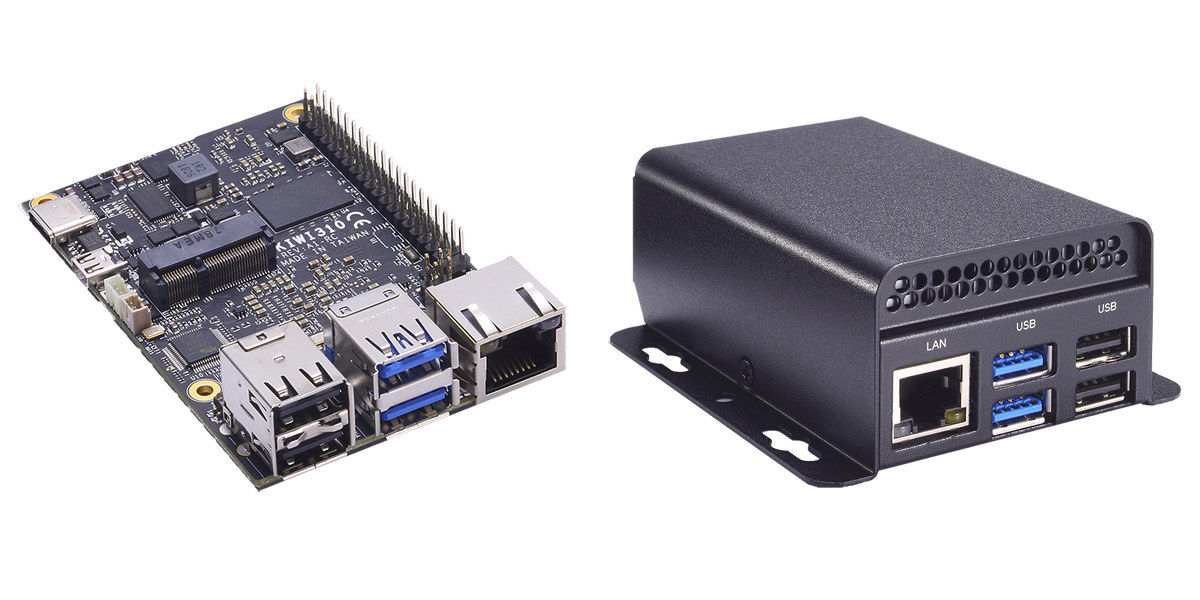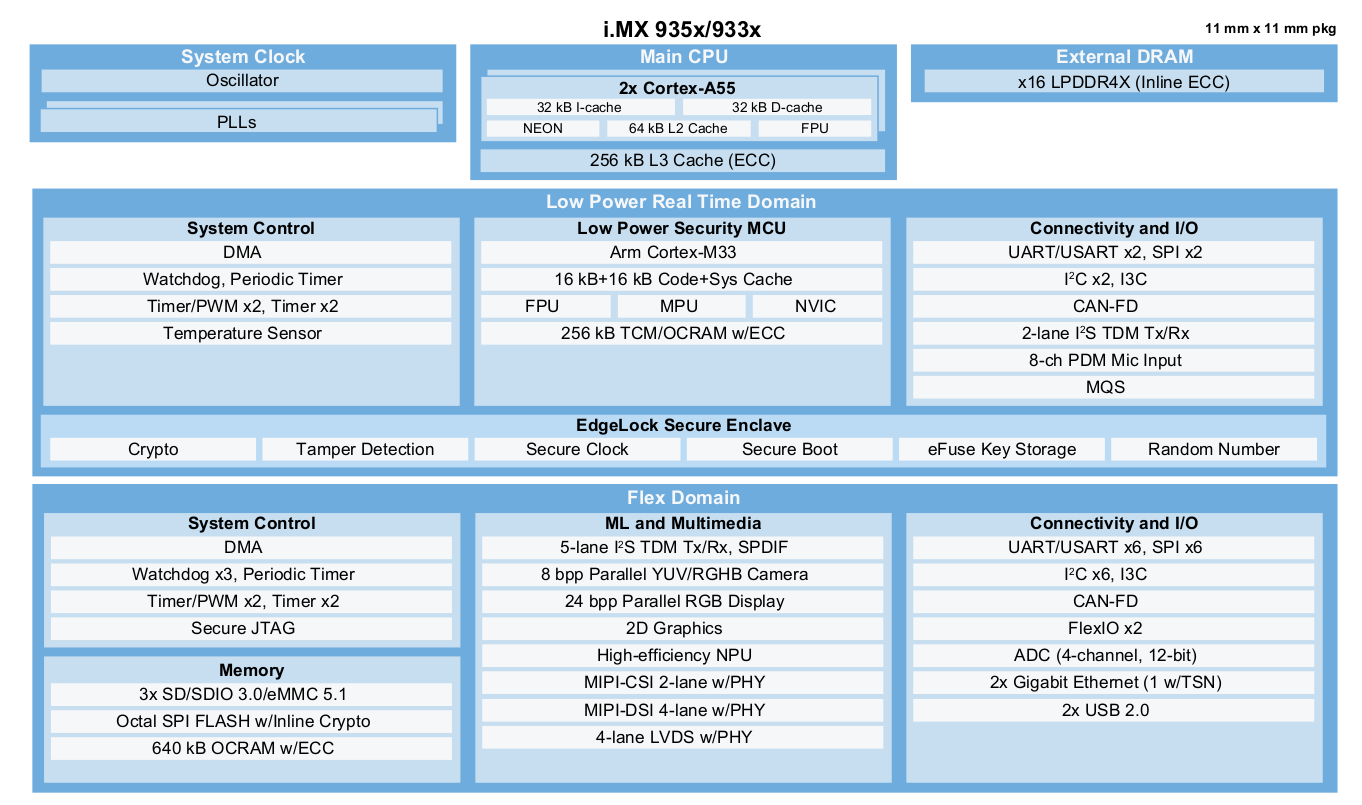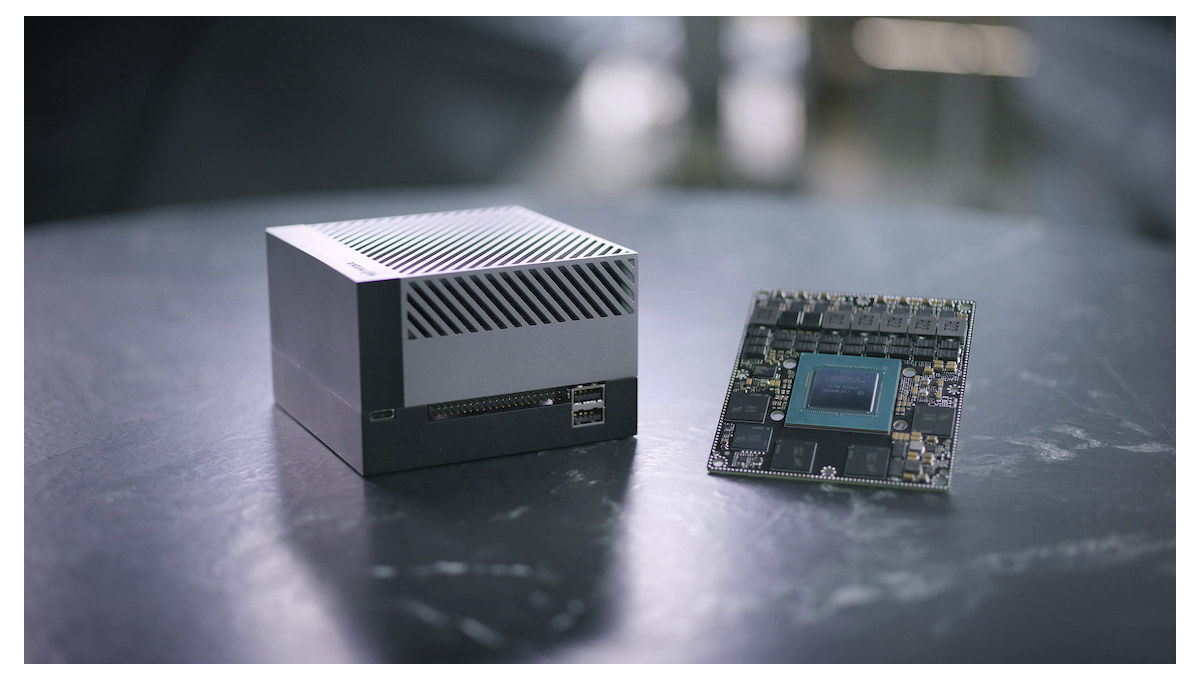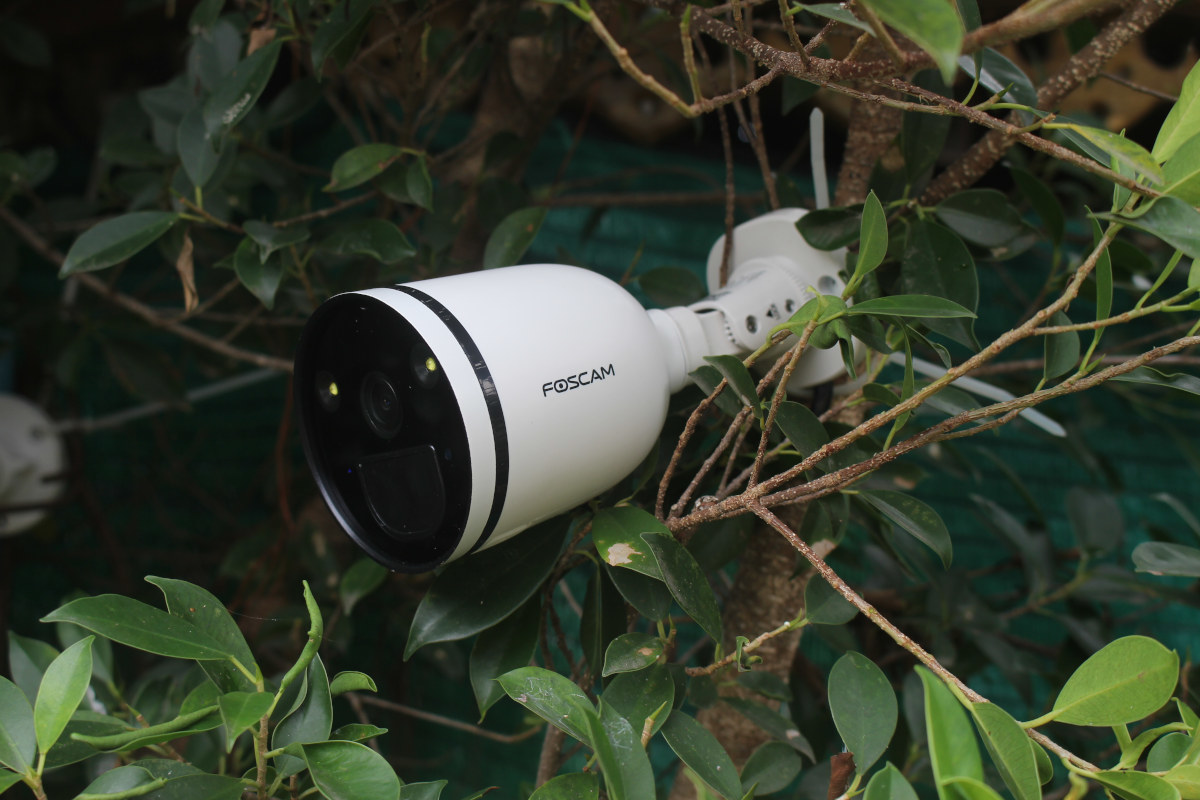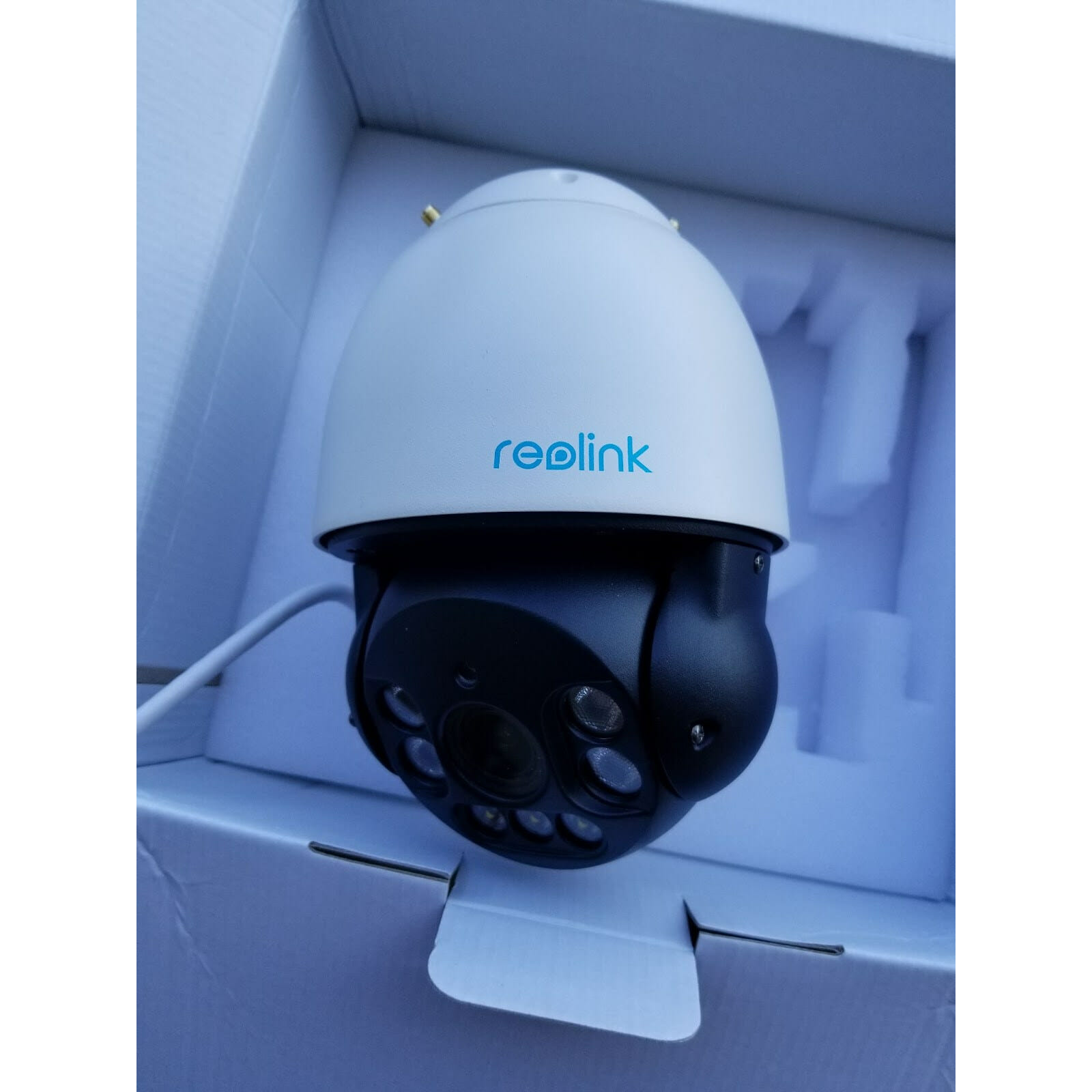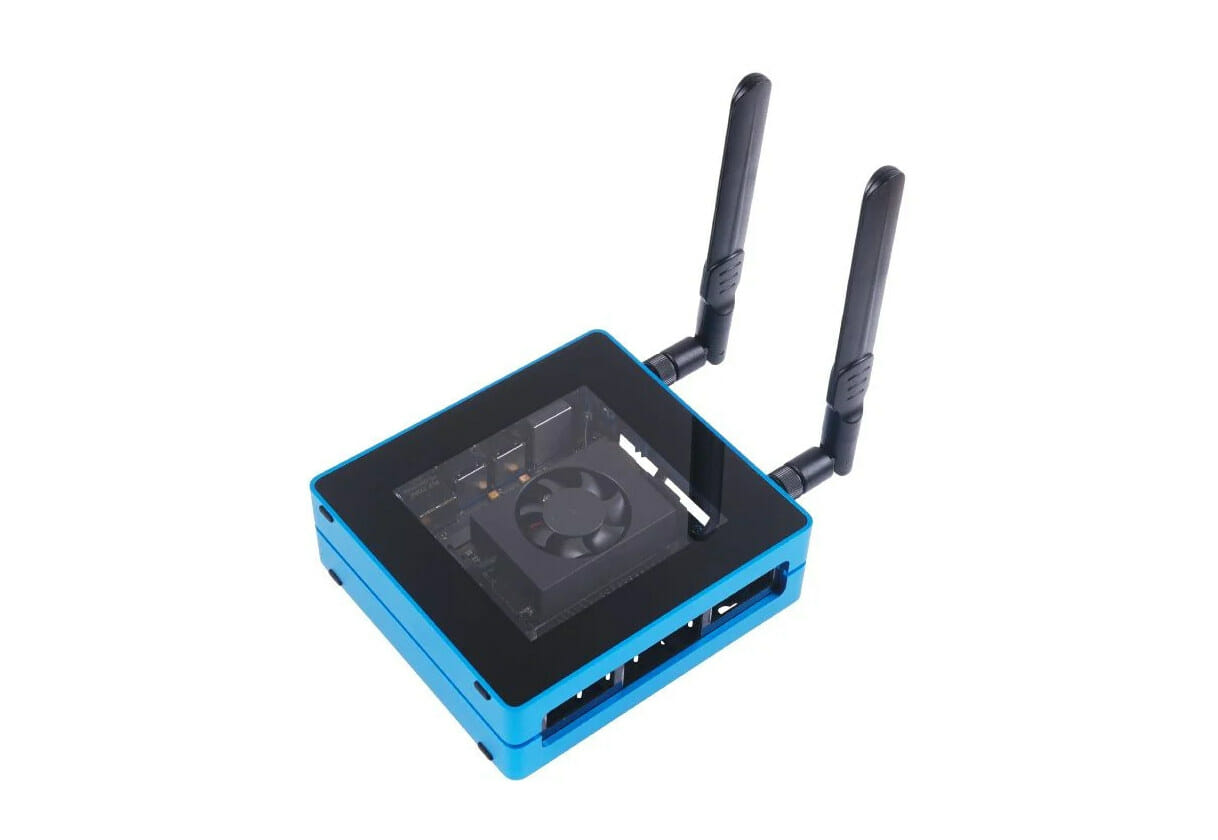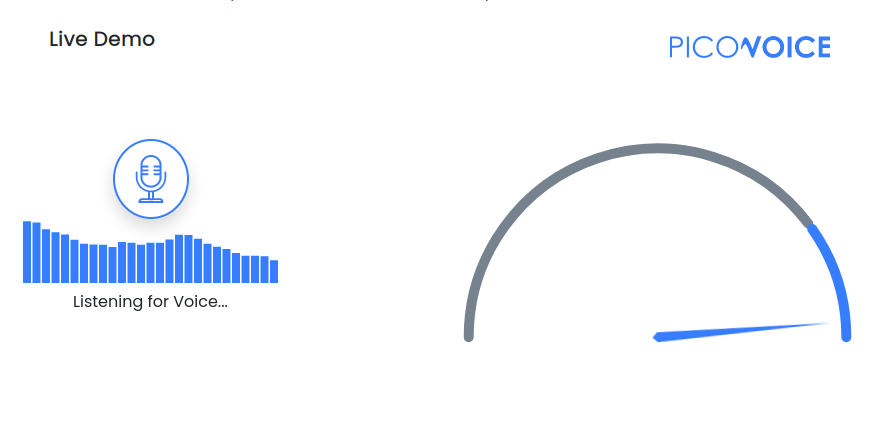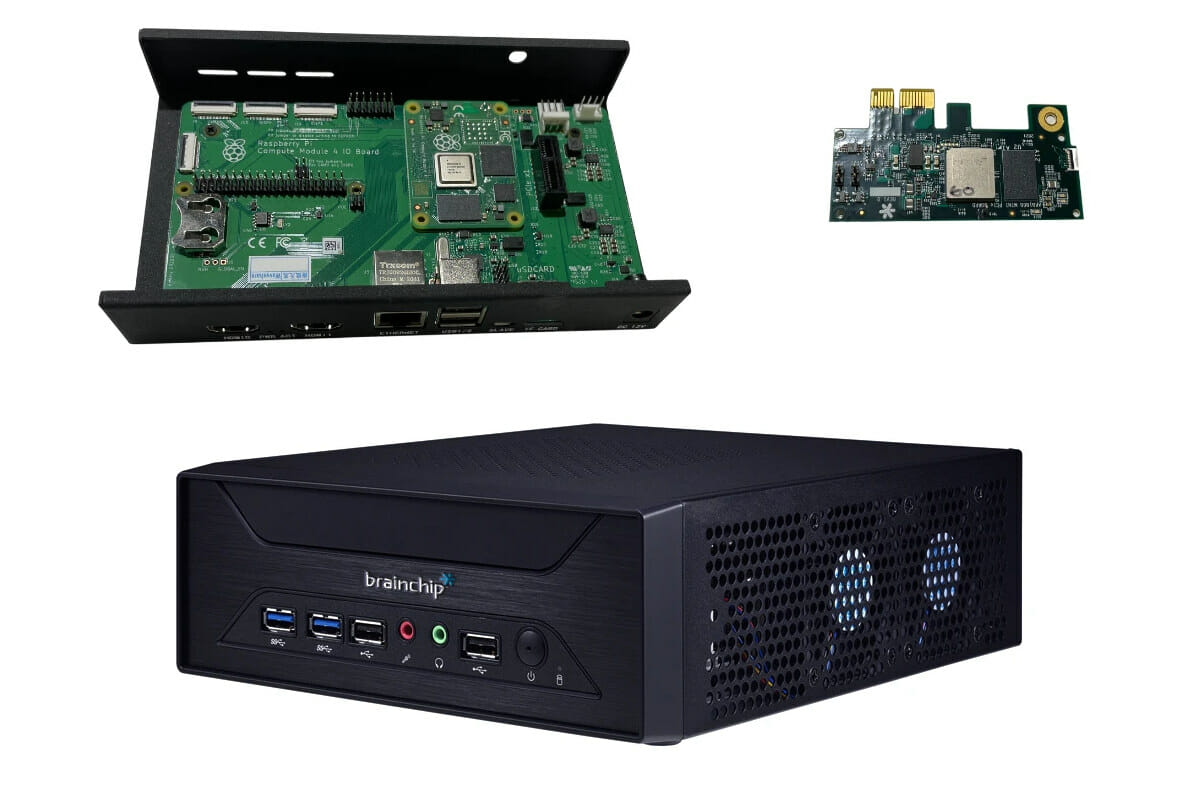Axiomtek KIWI310 may look like a Raspberry Pi SBC but it packs an Intel Celeron N3350 processor, an M.2 slot with support for Myriad X AI accelerator, and the company also offer a HAT with 5G cellular connectivity. The single board computer also comes with up to 4GB LPDDR4 memory, up to 64GB eMMC flash, a Micro HDMI port, two USB 3.0 and two USB 2.0 ports, as well as the ubiquitous 40-pin GPIO header. Power options are also an improvement over your typical Raspberry Pi board with USB-C PD as well as LiPo battery support. Axiomtek KIWI310 specifications: SoC – Intel Celeron N3350 dual-core Apollo Lake processor @ 1.1 GHz / 2.4 GHz (Turbo) with Intel HD Graphics 500; 6W TDP System Memory – Up to 4GB (specs) or 8GB (YouTube video) LPDDR4 Storage – Up to 64GB eMMC flash, SPI flash for AMI BIOS Video & audio output […]
NXP i.MX 93 processor combines Cortex-A55 cores with Ethos U65 microNPU
NXP has unveiled the i.MX 93 processor family comprised of i.MX 935x, 933x, 932x, and 931x parts at this time with up to two Cortex-A55 cores, one Arm Cortex-M33 real-time core, as well as an Ethos U65 microNPU for machine learning (ML). We wrote about i.MX 9 family back in March with NXP telling us it would include an Arm Ethos U-65 microNPU and EdgeLock secure enclave, be manufactured with a 16/12nm FinFET class process, and includes the “Energy Flex” architecture to optimize power consumption by turning on/off specific blocks in the processor. The NXP i.MX 93 is the first family leveraging those new features, and we know have some more details. NXP i.MX 93 processor specifications: CPU 1x or 2x Arm Cortex-A55 @ 1.7 GHz with 32KB I-cache, 32KB D-cache, 64KB L2 cache, 256KB L3 cache with ECC 1x Arm Cortex-M33 @ 250 MHz low power microcontroller with 256KB […]
NVIDIA Jetson AGX Orin 12-core Cortex-A78E module delivers up to 200 TOPS
The upcoming NVIDIA Jetson AGX Orin module packs some serious processing power with a 12-core Cortex-A78AE processor, 2048 CUDA cores, and 64 Tensor cores delivering up to 200 TOPS of AI performance, or 6 times more than its predecessor, the Jetson AGX Xavier module. Designed for robotics, autonomous machines, medical devices, the Jetson AGX Orin delivers the same performance as a GPU-enabled server, but in a much more compact 100 x 87mm form factor. The module can be operated in three power modes, namely 15W, 30W, or 50W depending on performance and power requirements, and a compact developer kit will also be made available. Jetson AGX Orin specifications: CPU – 12-core Arm Cortex-A78AE v8.2 64-bit processor with 3MB L2 + 6MB L3 cache GPU / AI accelerators NVIDIA Ampere architecture with 2048 NVIDIA CUDA cores and 64 Tensor Cores @ 1 GHz DL Accelerator – 2x NVDLA v2.0 Vision Accelerator […]
Giveaway Week – Foscam SPC IP Camera
The last prize for Giveaway Week 2021 was going to be Crowbits Master Kit ESP32 based educational kit. That’s until I realized there’s a battery inside the ESP32 module, and only more expensive shipping options like DHL or FedEx would be available. So I looked into my treasure box and found the Foscam SPC camera. It’s a 4K security camera with built-in human detection as well as a spotlight, hence the SPC naming, to be able to record color nighttime videos. As you might expect, there’s no battery inside, and that means you’d need a PoE injector, or rely on the included power adapter for power. I reviewed Foscam SPC with the Android app and ONVIF, and it worked pretty well. The spotlight does its job recording clear, colorful videos at night. The package still includes all accessories and quick setup guide as shown below. To enter the draw, simply […]
Reolink RLC-523WA & RLC-823A Review – Smart security cameras tested with Blue Iris
Hello, Karl here with a security camera review. I’ll start out by thanking Reolink for sending over two cameras to review: RLC-523WA (WiFi) & RLC-823A (PoE). I already had a couple of cameras from Reolink that my buddy had recommended a long time ago. And had a positive experience so I agreed to review these higher-end models. My setup with Blue Iris, unRAID I have been running unRAID for quite a while now to simplify my server requirements. I was running several small SBC’s and a standalone NAS drive and consolidated them onto my main rig. AMD has pushed desktop core counts with their Ryzen CPUs and I have cores to spare. I started with a 3700x giving 2 cores to applications leaving me with 6 cores for my VM’s but recently upgraded to a 3900x. I now give 3 to applications and 9 cores for my VM’s. I started […]
Jetson SUB mini PC ships with Xavier NX SoM, 128GB SSD
Jetson SUB is a mini PC powered by NVIDIA Jetson Xavier NX module and equipped with a 512GB 128GB SSD, a WiFi module, all housed in an aluminum case with a cooling fan. [Update Nov 1, 2021: Seeed Studio informed me the SSD would only have 128 GB capacity] Preloaded with NVIDIA Jetpack, the mini PC is designed for higher-end edge AI and IoT workloads leveraging the 384 NVIDIA CUDA cores, 48 Tensor cores, the hexa-core Carmel 64-bit Arm processor, and the two NVIDIA Deep Learning Accelerators (NVDLA) engines from the Xavier NX SoC. Jetson SUB mini PC specifications: NVIDIA Jetson Xavier NX module CPU – 6-core NVIDIA Carmel ARMv8.2 64-bit processor with 6 MB L2 + 4 MB L3 cache GPU – NVIDIA Volta architecture with 384 NVIDIA CUDA cores and 48 Tensor cores Accelerators – 2x NVDLA Engines, 7-Way VLIW Vision Processor Video – Multiple 4Kp60 encode, multiple […]
Picovoice Cobra Voice Activity Detection Engine shown to outperform Google WebRTC VAD
Picovoice Cobra Voice Activity Detection (VAD) engine has just been publicly released with support for Raspberry Pi, BeagleBone, NVIDIA Jetson Nano, Linux 64-bit, macOS 64-bit, Windows 64-bit, Android, iOS, and web browsers that support WebAssembly. Support for other Cortex-M and Cortex-A based SoCs can also be made available but only to enterprise customers. Picovoice already offered custom wake word detection with an easy and quick web-based training and offline voice recognition for Raspberry Pi, and even later ported their voice engine to Arduino. Cobra VAD is a new release, and, like other VADs, aims to detect the presence of a human voice within an audio stream. Picovoice Cobra can be found on Github, but note this is not an open-source solution, and instead, libpv_cobra.so dynamic library is provided for various targets, together with header files and demos in C, Python, Rust, and WebAssembly, as well as demo apps for iOS […]
BrainChip AKD1000 SNN AI SoC gets Raspberry Pi and x86 development kits
BrainChip has introduced two development kits for its Akida AKD1000 neuromorphic processor based on Raspberry Pi and an Intel (x86) mini PC in order to enable partners, large enterprises, and OEMs to begin testing and validation of the Akida chip. BrainChip Akida neural relies on spiking neural networks (SNN) which enable high-performance, real-time inference at ultra-low power, notably much lower power than traditional AI chips relying on CNN (convolutional neural network) technology. Akida Development Kit based on Raspberry Pi CM4 Specifications: SoM – Raspberry Pi CM4 or CM4 Lite with SoC: Broadcom BCM2711C0 quad-core ARM Cortex-A72 (ARMv8-A) 64-bit @ 1.5GHz plus Broadcom VideoCore VI GPU RAM – 1GB, 2GB, 4GB, or 8GB LPDDR4 SDRAM Storage – MicroSD card for CM4 Lite, or 2GB to 32GB eMMC for CM4 Networking – Optional 2.4 GHz and 5 GHz 802.11b/g/n/ac Wi-Fi, Bluetooth 5.0 LE, Gigabit Ethernet PHY Carrier board – Official Raspberry Pi […]


